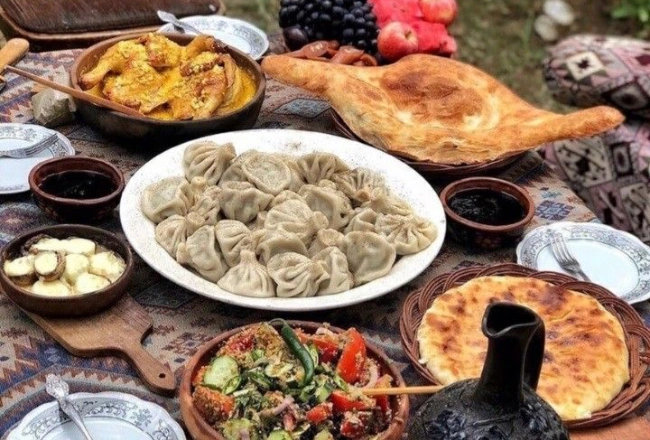Georgian Cuisine: A Taste of History and Soul
Georgian cuisine is much more than a collection of recipes — it is a reflection of the country's history, culture, and deep-rooted traditions of hospitality. With its bold flavors, rich textures, and warm communal spirit, Georgian food has captivated people around the world. From juicy khinkali dumplings to the cheesy perfection of khachapuri, every dish tells a story shaped by centuries of influence and innovation.
The origins of Georgian cuisine stretch back thousands of years. Archaeological evidence shows that as early as the 4th millennium BCE, the people of what is now Georgia were cultivating grapes, grains, and raising livestock. Nestled at the crossroads of Europe and Asia, Georgia became a hub of trade and cultural exchange. As a result, its culinary traditions were enriched by Persian, Turkish, Arabic, Byzantine, and later Russian influences — yet they always retained a uniquely Georgian identity.
Georgian food is deeply regional, shaped by the diverse geography of the country — from high mountain villages to subtropical coasts. Each region developed its own specialties and flavor profiles. Dishes like khinkali, once a hearty mountain meal for shepherds, became national staples. Satsivi, a rich walnut-based sauce often served with poultry, reflects the importance of nuts in Georgian cooking, while dishes like lobio (spiced bean stew) and pkhali (vegetable and walnut spreads) showcase the creativity born from periods of religious fasting.
Religion played a key role in shaping the cuisine. As one of the world’s oldest Christian nations, Georgia developed many vegetarian and fasting dishes to observe Orthodox Christian traditions. These dishes, often based on beans, eggplant, and nuts, are now considered some of the culinary highlights of the country.
One of the most iconic elements of Georgian culture is wine. Georgia is widely recognized as one of the world’s oldest wine-producing regions, with a tradition dating back over 8,000 years. The method of fermenting wine in large clay vessels called qvevri is unique to Georgia and has been recognized by UNESCO as an Intangible Cultural Heritage. In Georgian culture, wine is inseparable from the dining experience — no supra (feast) is complete without it. Toasts, music, and storytelling transform each meal into a celebration of life, family, and community.
Despite centuries of invasions and foreign rule, Georgian cuisine has remained remarkably authentic. It is a living tradition, passed down through generations, still thriving in village homes, urban restaurants, and festive gatherings. In recent years, the world has begun to discover what Georgians have always known — that their food is a treasure not just of taste, but of heart and heritage.

Ancient Roots and Crossroads of Culture
The origins of Georgian cuisine date back thousands of years. Archaeological discoveries suggest that as early as the 4th millennium BCE, people in the region were cultivating grapes, making wine, baking bread in clay ovens, and developing livestock-based diets. Located at the crossroads of Europe and Asia, Georgia absorbed diverse culinary influences from Persian, Ottoman, Arabic, Byzantine, Central Asian, and later Russian traditions — and yet, it always preserved its unique Georgian identity.
Each invader or trader brought new spices, ingredients, and techniques, which Georgians adopted with creativity and made their own. But unlike in many cultures where influence led to assimilation, Georgia maintained a distinct, proud, and deeply rooted culinary voice.
🏞️ A Cuisine of Regions
Georgia’s diverse geography — from the snow-capped Caucasus Mountains to the Black Sea coast — gave rise to regional specialties with unique flavor profiles. In the highlands of Tusheti and Khevsureti, hearty meat dishes and khinkali sustained shepherds and villagers. In the lush valleys of Imereti and Racha, herbs, walnuts, and cheeses took center stage. Mingrelian cuisine is famous for its spicy flavors and generous use of garlic and ajika (a hot chili paste), while Adjara, near the coast, offers the iconic Adjarian khachapuri — a boat-shaped bread filled with cheese, butter, and egg.
Vegetarian staples like lobio (bean stew), pkhali (minced vegetables with walnuts and garlic), and grilled eggplant with walnut paste reflect the creativity born from centuries of religious fasting and seasonal living. These dishes are now beloved far beyond their original context — simple yet deeply flavorful, rustic yet refined.
✝️ Faith, Food, and Fasting
Georgia’s embrace of Christianity in the 4th century played a major role in shaping its food culture. The Orthodox tradition of regular fasting led to the creation of plant-based dishes that are both satisfying and nutritious. These meals, while born from religious devotion, highlight the Georgian ability to transform humble ingredients — like beans, herbs, and nuts — into something rich and celebratory.
🍷 The Legacy of Wine
No discussion of Georgian cuisine is complete without wine. Considered the cradle of winemaking, Georgia has a viticultural history that spans over 8,000 years. The traditional qvevri method — where wine is fermented and aged in large clay vessels buried underground — is still practiced today and has earned UNESCO recognition.
Wine is integral to Georgian identity. It flows freely at every supra (feast), where meals are elevated into ceremonial gatherings full of heartfelt toasts, traditional polyphonic songs, and storytelling. The tamada (toastmaster) leads the table, guiding both conversation and emotion, making the meal a spiritual and communal experience.
❤️ A Living, Loving Tradition
What sets Georgian cuisine apart is not just its flavor but its spirit. Meals are meant to be shared — with family, friends, neighbors, and even strangers. Every table reflects warmth, generosity, and pride, and every recipe is a chapter in a story passed down through generations.
Even in the face of centuries of foreign rule and modern globalization, Georgian food has remained remarkably authentic. Today, it thrives both in bustling Tbilisi restaurants and in quiet village homes. And now, the world is beginning to discover what Georgians have always known — that this cuisine is a treasure not just of taste, but of history, heart, and heritage.
Georgian cuisine is not just something you eat — it’s something you experience. It is full of warmth, character, and soul, bringing people together and telling the story of a resilient and passionate culture with every bite.

Close